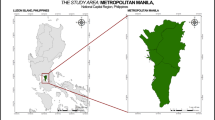Abstract
Some settlements were located in unsuitable regions due to limited land resources in mountainous areas, some settlements were even even constructed in areas prone to geological hazards in Southwest China. Therefore, it was important to evaluate the spatial appropriateness of a region and determine the areas that were unsuitable for settlements, and then find out the settlements located in unsuitable regions. It will assist in decision making associated with the relocation of settlements. Furthermore, it will be the key to ensure the safety of inhabitants and promoting sustainable development in mountainous areas. This study explored the coupling mechanism between suitable space and rural settlements in the upper Minjiang River basin, which is an ecologically fragile area with high-frequency of natural hazards. Firstly, we identified relief degree of land surface (RDLS), elevation, and disaster risk as the limiting factors. Then, by determining the thresholds of these limiting factors, we recognized the suitable areas for inhabitation in the upper Minjiang River basin with GIS. Finally, using the distribution map of rural settlements and that of suitable space, the distribution of rural settlements located at unsuitable area was obtained by coupling relationship analysis. Consequently, an in-depth understanding of this relationship was achieved as follows: (1) The suitable space of the upper Minjiang River basin is 13.7 thousand km2, accounting for 54.9% of the total land space; (2) There were 196 settlements located in the unsuitable area, the total area of these settlements was 125.27 km2, and there were 68000 people in these settlements, accounting for 17.65% of the total population; (3) There were 65 settlements located near mountain hazard areas, accounting for 4.9% of the total. These findings suggest that it was necessary to carefully investigate settlements with risks and develop targeted relocation policies to help find the most effective way of using land safely and to good effect. The details are as follows: (1) Fully consider the safety of residents: For the 196 settlements distributed in the unsuitable region, the government should undertake a point-by-point survey and classify these settlements into different categories for relocation; (2) For the 65 settlements closely related with mountain hazards, professional geological prospecting teams should be organized to conduct a field survey at each point; (3) Besides considering the safety of residents during the relocation process, it is necessary to pay more attention to the cultural customs of inhabitants and livelihood sustainability
Similar content being viewed by others
References
Chen Y, Chen GJ, Yang DG (2004) Distribution of human settlements in the upstream Min River and their ecological characteristics — a case study of Lixian County. Resources and Environment in the Yangtze Basin. 13(1)172–77.
Ding MT, Cheng ZL, Wang Q (2014) Coupling mechanism of rural settlements and mountain disasters in the upper reaches of Min River. Journal of Mountain Science 11(1): 66–72. https://doi.org/10.1007/s11629-012-2366-x
Feng ZM, Yang T, Yang YZ, et al. (2008) Relief degree of land surface and its influence on population distribution in China. Journal of Geographical Sciences 18: 237–246.
Hu YC, Fang YD, Feng ZM, et al. (2009) The relief degree of land surface and its correlation with population distribution in urban agglomerations of China. In: International Conference on Industrial and Information Systems. Hai Kou, China. pp 97–100. https://doi.org/10.1109/IIS.2009.52
Ladd HF (1992) Population growth, density and the costs of providing public services. Urban Studies 29(2): 273–295.
Li CW, Liang SB, Che QJ (2015) Spatial reconstruction of the rural settlements in wu hu city based on the function oriented zoning. Resource and environment in the Yangtze basin (24)10:1736–1743. (In Chinese). https://doi.org/10.11870/cjlyzyhj201510016
Liu Y, Deng W, Song XQ (2015) Relief Degree of Land Surface and Population Distribution of Mountainous Areas in China. Journal of Mountain Science 12(2): 518–532. https://doi.org/10.1007/s11629-013-2937-5
Liu Y, Deng W, Song XQ (2015) Population Density Correction Method in Mountain Areas Based on Relief Degree of Land Surface: A Case Study in the Upper Minjiang River Basin. Scientia Geography Sinica 35(4): 464–470. (In Chinese) https://doi.org/10.13249/j.cnki.sgs.2015.04.011
Liu YG, Huang CM, Wang Q, et al. (2018) Assessment of Sustainable Livelihood and Geographic Detection of Settlement Sites in Ethnically Contiguous Poverty-Stricken Areas in the Aba Prefecture, China. ISPRS International Journal of Geo-information 1(7): 1–18.
Meng GC, Wang SG, Xie H, et al. (2005) Characteristics of Debris Flow Disasters in the upper Reaches of Minjiang River. Journal of Catastrophology 20(3): 94–98
Qi ZX, Liao JJ, Xu WH, et al. (2015) Suitability analysis of mountain settlements in Qinling using a GIS system. ActaEcologicaSinica (35)4: 1274–1283. (In Chinese). https://doi.org/10.5846/stxb201305020899
Shan YB, Ma XD, Xuan Y (2012) Suitability Analysis of the Rural Settlements in Xuzhou Based on GIS. Areal Research and Development (31)6:156–160. (In Chinese)
Zhu XX, Wang HM, Yuan XJ, et al. (2010) Evaluation and optimization of spatial distribution of rural settlements based on GIS. Transactions of the CSAE. https://doi.org/10.3969/j.issn.1002-6819.2010.06.057
Author information
Authors and Affiliations
Corresponding author
Additional information
Acknowledgments
This work was funded by The National Natural Science Foundation of China (Grant NOs. 41801140, 41930651 and 41771194). Any opinions, findings, and conclusions or recommendations expressed in this material are those of the author(s) and do not necessarily reflect the views of the sponsoring parties mentioned above. We would like to thank Editage (http://www.editage.cn) for English language editing.
Supplementary Material
Rights and permissions
About this article
Cite this article
Liu, Y., Deng, W. & Peng, L. The coupling mechanism between the suitable space and rural settlements considering the effect of mountain hazards in the upper Minjiang River basin. J. Mt. Sci. 17, 2774–2783 (2020). https://doi.org/10.1007/s11629-019-5909-6
Received:
Revised:
Accepted:
Published:
Issue Date:
DOI: https://doi.org/10.1007/s11629-019-5909-6




